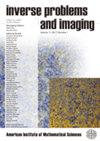$ \chi^2 $检验用于总变分正则化参数选择
IF 1.5
4区 数学
Q2 MATHEMATICS, APPLIED
引用次数: 5
摘要
Total Variation (TV) is an effective method of removing noise in digital image processing while preserving edges. The scaling or regularization parameter in the TV process defines the amount of denoising, with a value of zero giving a result equivalent to the input signal. The discrepancy principle is a classical method for regularization parameter selection whereby data is fit to a specified tolerance. The tolerance is often identified based on the fact that the least squares data fit is known to follow a \begin{document}$ \chi^2 $\end{document} distribution. However, this approach fails when the number of parameters is greater than or equal to the number of data. Typically, heuristics are employed to identify the tolerance in the discrepancy principle and this leads to oversmoothing. In this work we identify a \begin{document}$ \chi^2 $\end{document} test for TV regularization parameter selection assuming the blurring matrix is full rank. In particular, we prove that the degrees of freedom in the TV regularized residual is the number of data and this is used to identify the appropriate tolerance. The importance of this work lies in the fact that the \begin{document}$ \chi^2 $\end{document} test introduced here for TV automates the choice of regularization parameter selection and can straightforwardly be incorporated into any TV algorithm. Results are given for three test images and compared to results using the discrepancy principle and MAP estimates.本文章由计算机程序翻译,如有差异,请以英文原文为准。
$ \chi^2 $ test for total variation regularization parameter selection
Total Variation (TV) is an effective method of removing noise in digital image processing while preserving edges. The scaling or regularization parameter in the TV process defines the amount of denoising, with a value of zero giving a result equivalent to the input signal. The discrepancy principle is a classical method for regularization parameter selection whereby data is fit to a specified tolerance. The tolerance is often identified based on the fact that the least squares data fit is known to follow a \begin{document}$ \chi^2 $\end{document} distribution. However, this approach fails when the number of parameters is greater than or equal to the number of data. Typically, heuristics are employed to identify the tolerance in the discrepancy principle and this leads to oversmoothing. In this work we identify a \begin{document}$ \chi^2 $\end{document} test for TV regularization parameter selection assuming the blurring matrix is full rank. In particular, we prove that the degrees of freedom in the TV regularized residual is the number of data and this is used to identify the appropriate tolerance. The importance of this work lies in the fact that the \begin{document}$ \chi^2 $\end{document} test introduced here for TV automates the choice of regularization parameter selection and can straightforwardly be incorporated into any TV algorithm. Results are given for three test images and compared to results using the discrepancy principle and MAP estimates.
求助全文
通过发布文献求助,成功后即可免费获取论文全文。
去求助
来源期刊

Inverse Problems and Imaging
数学-物理:数学物理
CiteScore
2.50
自引率
0.00%
发文量
55
审稿时长
>12 weeks
期刊介绍:
Inverse Problems and Imaging publishes research articles of the highest quality that employ innovative mathematical and modeling techniques to study inverse and imaging problems arising in engineering and other sciences. Every published paper has a strong mathematical orientation employing methods from such areas as control theory, discrete mathematics, differential geometry, harmonic analysis, functional analysis, integral geometry, mathematical physics, numerical analysis, optimization, partial differential equations, and stochastic and statistical methods. The field of applications includes medical and other imaging, nondestructive testing, geophysical prospection and remote sensing as well as image analysis and image processing.
This journal is committed to recording important new results in its field and will maintain the highest standards of innovation and quality. To be published in this journal, a paper must be correct, novel, nontrivial and of interest to a substantial number of researchers and readers.
 求助内容:
求助内容: 应助结果提醒方式:
应助结果提醒方式:


